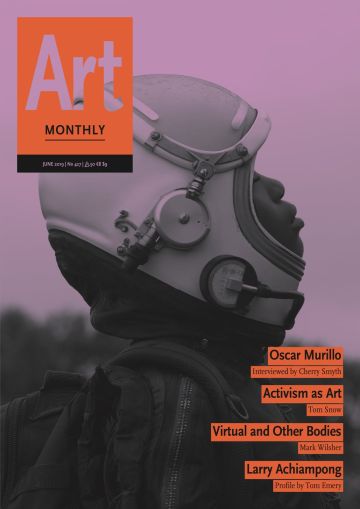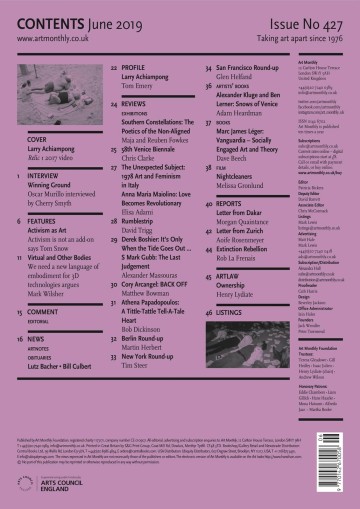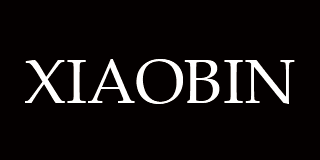Art Monthly 427
June 2019
Oscar Murillo
Interviewed by Cherry Smyth
Activism as Art
Tom Snow
Virtual and Other Bodies
Mark Wilsher
Larry Achiampong
Profile by Tom Emery
Buy Now – select:
Want to read this right now?
Get instant access to the entire back catalogue via Exact Editions from only £8.99!
Contents
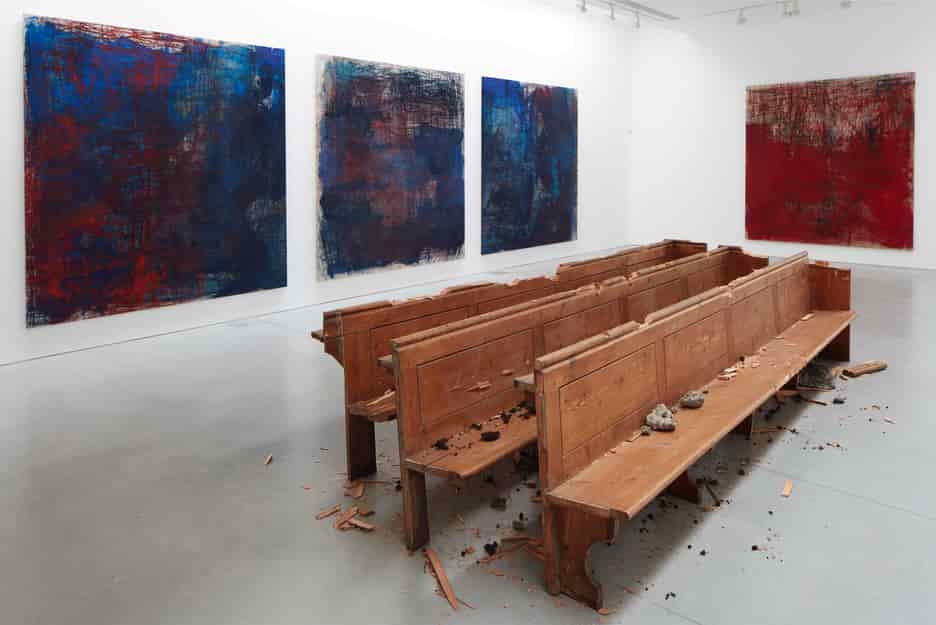
Oscar Murillo ‘Violent Amnesia’ 2019 installation view
Kettle’s Yard, Cambridge
Interview
Winning Ground
Oscar Murillo interviewed by Cherry Smyth
The London-based Afro-Colombian artist discusses race and colonialism, the collective experience and the individual, cultural displacement and infiltration.
The physical energy that happens in the studio remains present beyond the action and the sense of labour is transferred to the space and the viewer. But somehow that is not enough. If you think of a dynamo that transfers energy to something else, in this show the pews carry that through, suggesting the link between colonialism and the church.
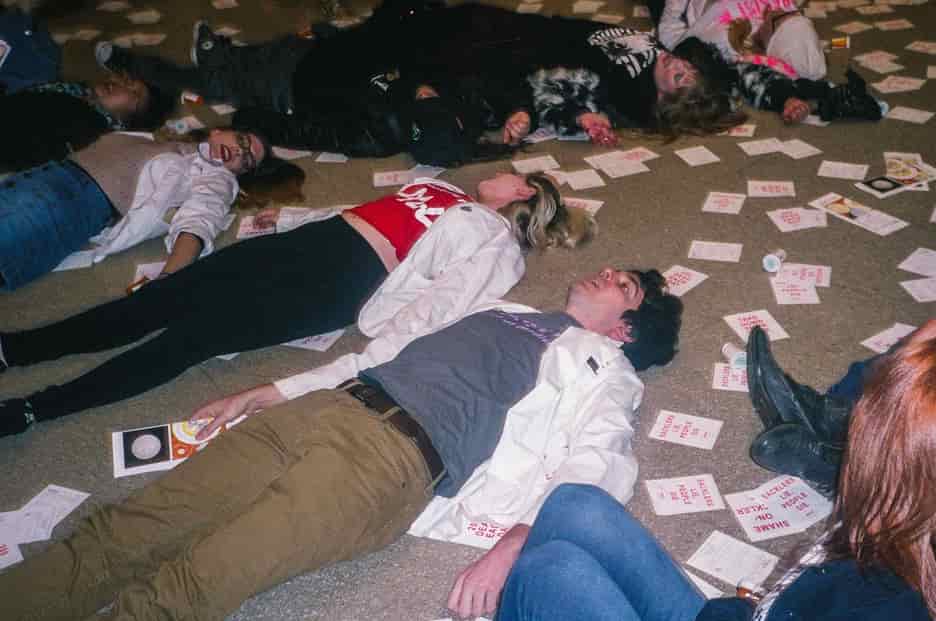
activists from PAIN (Prescription Addiction Intervention Now) performing a
die-in against Sackler’s funding of the Guggenheim Museum, New York, 2019
photo by Arda Arsena
Feature
Activism as Art
Activism is not an add-on says Tom Snow
It is time that museums recognised activism as central to critical art practices by individuals and collectives, such as Liberate Tate, PAIN, and BP or not BP?
The capacity of museums to represent and comment on current art and artists is flawed by the refusal to take note of their politically engaged contemporary activities. Tate and other institutions are potentially at risk of something similar by refusing to see activism as a serious component of contemporary practice.
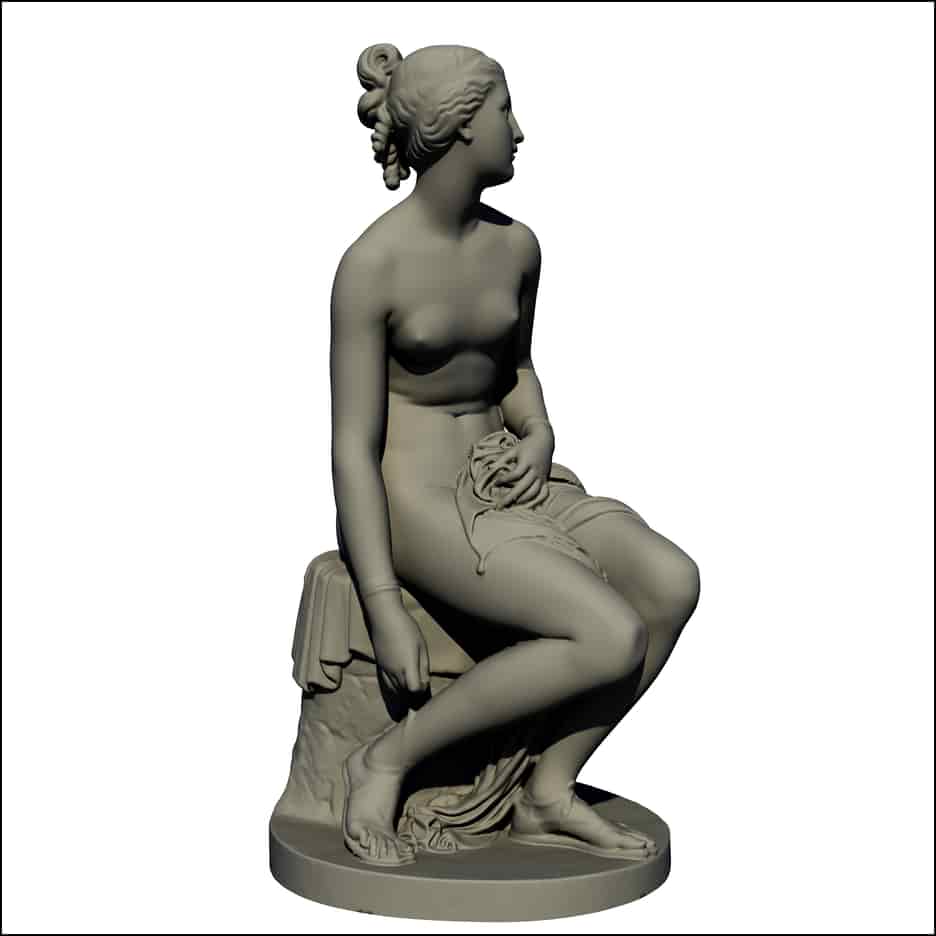
Oliver Laric Lincoln 3D Scans 2012-
Feature
Virtual and Other Bodies
We need a new language of embodiment for 3D technologies argues Mark Wilsher
The unnerving feelings of dissociation triggered by the works of artists such as Oliver Laric, Laurie Anderson and Rachel Rossin show that, if we are to spend more time in the virtual world, it is important not to leave the body behind.
No matter what the content, no matter who the programmer, a virtual space created purely from data and navigable without any relationship to our situated bodies will always represent a patriarchal mode of experience because it is ultimately a dissociated one. It denies the body in order to more easily colonise space.
Comment
Editorial
Venice: Through a Glass Darkly
Venice is being swamped by tourists who are collectively destroying the cultural jewel they have come to visit. The international art crowd is part of this nihilistic tendency, so has the time now come to radically rethink our own relationship with the mother of all biennales?
‘You’re asking me what it’s like to live with this crap? It used to be wonderful, we had lots of artisans … The problem now is the mass tourism, the people who come for just a few hours and see nothing – it’s as much of a nightmare for them.’
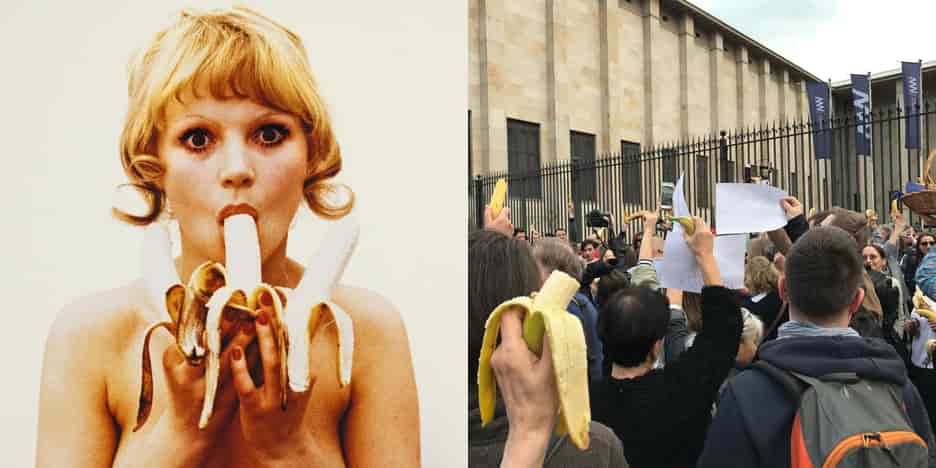
Natalia LL’s Consumer Art 1973 which was censored from the Warsaw National Museum and the banana-eating protest that ensued
photo Annabelle Chapman
Artnotes
ACAVAaargh
Studio provider ACAVA has had one of its studio blocks repossessed, locking out more than two dozen artists; artists protest at Tate’s renewed contact with Anthony d’Offay; the Czech culture minister resigns after his politically motivated sacking of museum directors; protesters in Poland stage a mass banana-eating outside the National Museum in support of a censored artwork; Trevor Paglen’s ambitious satellite sculpture Orbital Reflector is officially declared lost in space, a victim of President Donald Trump’s government shutdown; plus the latest news on galleries, appointments, prizes and more.
Obituaries
Lutz Bacher
Bill Culbert
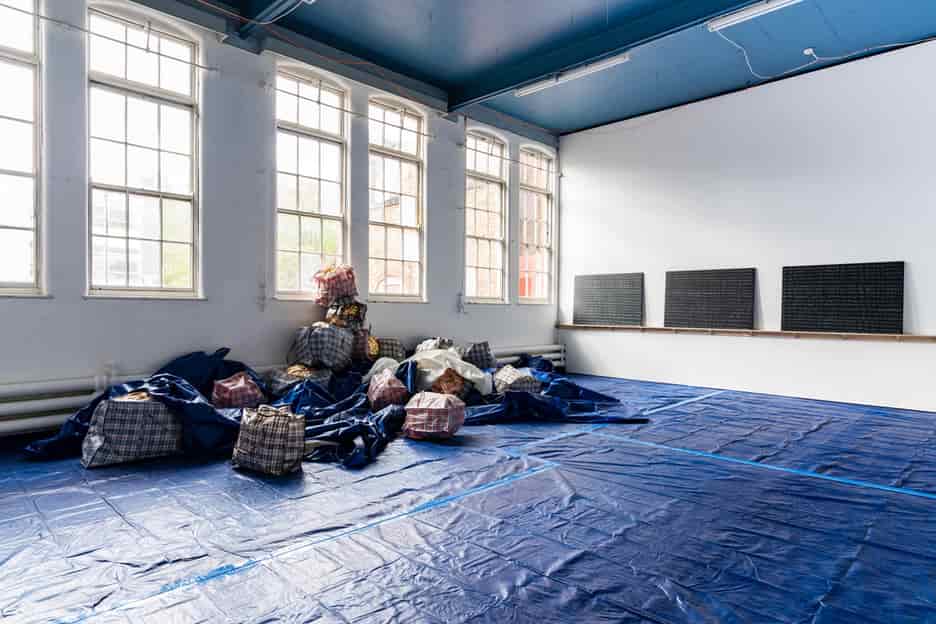
Larry Achiampong ‘Dividednation’ installation view, Primary, Nottingham
Profile
Larry Achiampong
Tom Emery discusses the thematic richness of ‘Relic Traveller’, the most recent work of the London-based multi-disciplinary artist.
Two near simultaneous political events form key influences for Larry Achiampong’s vision of the future: in June 2016 the UK voted to leave the European Union; weeks later in July, the African Union launched a passport programme that, when realised, will entitle holders to freedom of movement across all African nations.
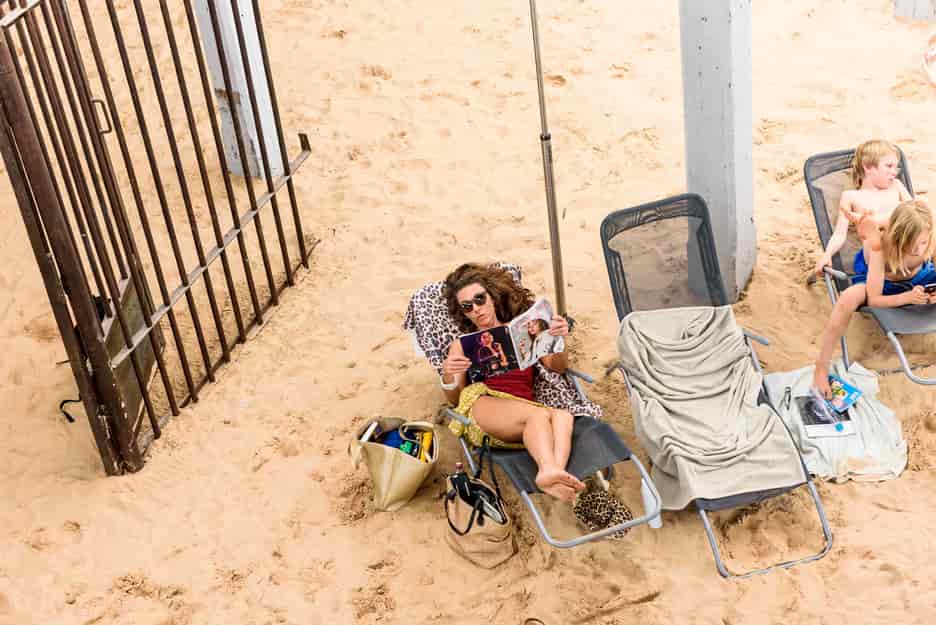
Rugile Barzdziukaite, Vaiva Grainyte & Lina Lapelyte
Sun & Sea (Marina) 2019 Lithuanian pavilion, Venice
Exhibitions
Southern Constellations: The Poetics of the Non-Aligned
Moderna Galerija and Museum of Contemporary Art Metelkova, Ljubljana
Maja and Reuben Fowkes
58th Venice Biennale
various venues
Chris Clarke
The Unexpected Subject: 1978 Art and Feminism in Italy
FM Centre for Contemporary Art, Milan
Anna Maria Maiolino: Love Becomes Revolutionary
PAC Padiglione d’Arte Contemporanea, Milan
Elisa Adami
Rumblestrip
g39, Cardiff
David Trigg
Derek Boshier: It’s Only When the Tide Goes Out ...
S Mark Gubb: The Last Judgement
Oriel Mostyn, Llandudno
Alexander Massouras
Cory Arcangel: BACK OFF
Firstsite, Colchester
Matthew Bowman
Athena Papadopoulos: A Tittle-Tattle Tell-A-Tale Heart
Humber Street Gallery, Hull
Bob Dickinson
Berlin Round-up
Capitain Petzel • BQ • Martin-Gropius-Bau • KOW
Martin Herbert
New York Round-up
Queer Thoughts • Bodega • Ludlow 38
Tim Steer
San Francisco Round-up
Altman Siegel • Oakland Museum of California • SFMOMA and Yerba Buena Center for the Arts
Glen Helfand
Reviews
Artists’ Books
Alexander Kluge and Ben Lerner: The Snows of Venice
Adam Heardman
As all good artists’ books should be, The Snows of Venice is a collision-site between thought, image and material.
Reviews
Books
Marc James Léger: Vanguardia – Socially Engaged Art and Theory
Dave Beech
This survey of political art doubles as a guided tour of anti-capitalist political theory from May ’68 to Occupy.
Reviews

May Hobbs speaking in Hyde Park at a demonstration against the Industrial Relations Bill, 1971 footage not used in Nightcleaners
Film
Nightcleaners
Melissa Gronlund
These texts weave together a composite picture of that incredible era of film activism.
Reports
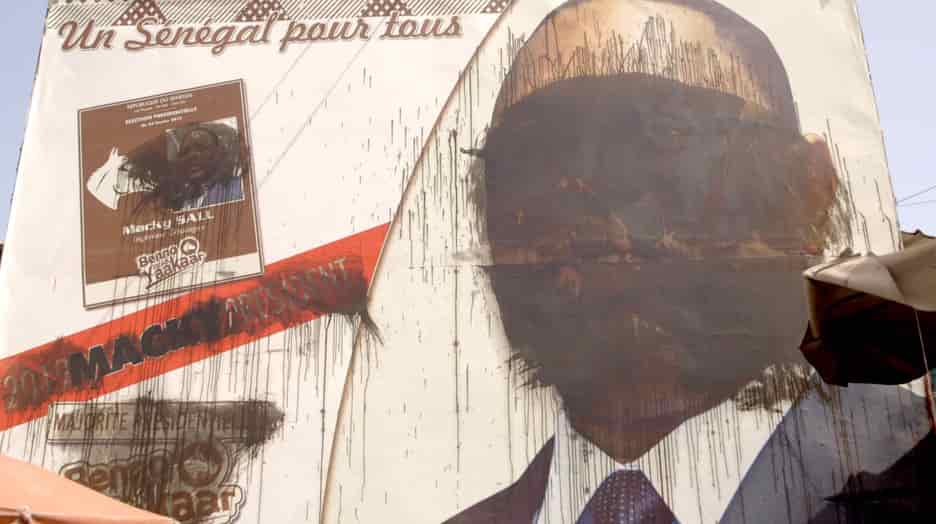
defaced campaign billboard
Letter from Dakar
The Neocolonial Trinity
Morgan Quaintance
I left Dakar still convinced that the true future of international art and culture has to be exchange, collaboration and support from the ground up, not the top down.
Reports

Anna Winteler Horizontal Waltz for Left and Right Handcameras 1989 video
Letter from Zurich
Cinderellas
Aoife Rosenmeyer
Women who have managed to survive into old age while maintaining a practice that we contemporary viewers can read without straining ourselves too much are not only agreeable but even in short supply – a win-win for the market.
Reports
Protest
Extinction Rebellion
Rob La Frenais
Gavin Turk made headlines by getting arrested and was present at many of the actions, but others, such as Jennet Thomas, Ackroyd/Harvey and Hercules Fisherman, were key to the rebellion’s cell-like structures.
Artlaw
Ways of Working
Ownership
Henry Lydiate
When is a ‘work’ completed? Is it when the artist releases it for public viewing, and/or only if released for sale? What is the status of a work an artist (or a deceased artist’s estate) disowns after its release?
Listings
Events
Calendar
The updated events and exhibitions calendar can be viewed online.
Exhibitions
Exhibition Listings
Art Monthly's exhibition listings can be viewed online.

